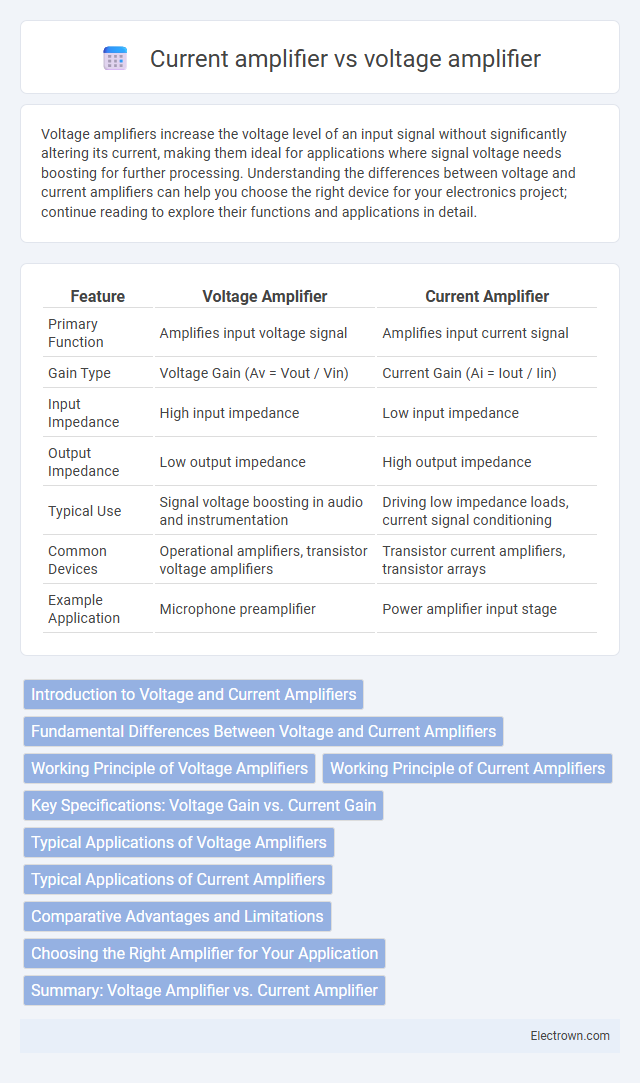Voltage amplifiers increase the voltage level of an input signal without significantly altering its current, making them ideal for applications where signal voltage needs boosting for further processing. Understanding the differences between voltage and current amplifiers can help you choose the right device for your electronics project; continue reading to explore their functions and applications in detail.
Table of Comparison
| Feature | Voltage Amplifier | Current Amplifier |
|---|---|---|
| Primary Function | Amplifies input voltage signal | Amplifies input current signal |
| Gain Type | Voltage Gain (Av = Vout / Vin) | Current Gain (Ai = Iout / Iin) |
| Input Impedance | High input impedance | Low input impedance |
| Output Impedance | Low output impedance | High output impedance |
| Typical Use | Signal voltage boosting in audio and instrumentation | Driving low impedance loads, current signal conditioning |
| Common Devices | Operational amplifiers, transistor voltage amplifiers | Transistor current amplifiers, transistor arrays |
| Example Application | Microphone preamplifier | Power amplifier input stage |
Introduction to Voltage and Current Amplifiers
Voltage amplifiers increase the amplitude of input voltage signals while maintaining current levels, making them ideal for applications requiring high input impedance and voltage gain. Current amplifiers boost the input current without significantly increasing voltage, suited for situations needing high current output to drive loads like speakers or motors. Understanding the distinction helps you select the appropriate amplifier type to optimize signal processing in electronic circuits.
Fundamental Differences Between Voltage and Current Amplifiers
Voltage amplifiers increase the amplitude of input voltage signals without significantly altering the current, emphasizing high input impedance and low output impedance for effective voltage gain. Current amplifiers, in contrast, boost input current levels while maintaining voltage stability, characterized by low input impedance and high output impedance to deliver higher current gain. These fundamental differences define their applications, where voltage amplifiers suit signal conditioning and audio electronics, and current amplifiers excel in driving low-impedance loads and power amplification.
Working Principle of Voltage Amplifiers
Voltage amplifiers work by increasing the input voltage signal while maintaining its waveform shape and frequency, primarily through the use of active components like transistors or operational amplifiers in their circuit design. They operate by controlling the output voltage proportional to the input voltage, utilizing feedback mechanisms to stabilize gain and reduce distortion. Your audio or signal processing systems rely on voltage amplifiers for precise amplification of weak voltage signals without significantly increasing current.
Working Principle of Current Amplifiers
Current amplifiers operate by increasing the current level of an input signal while maintaining the original voltage, using a low input impedance and high output impedance to ensure efficient current transfer to the load. They rely on active devices like transistors or operational amplifiers configured to provide gain through controlled current flow, often leveraging feedback mechanisms to stabilize and regulate the output current. The working principle fundamentally contrasts with voltage amplifiers, as current amplifiers prioritize current gain to drive loads requiring higher current without significant voltage increase.
Key Specifications: Voltage Gain vs. Current Gain
Voltage amplifiers primarily focus on voltage gain, which is the ratio of output voltage to input voltage, making them suitable for applications requiring signal voltage amplification without significantly increasing current. Current amplifiers emphasize current gain, defined as the ratio of output current to input current, ideal for driving loads requiring higher current levels while maintaining voltage stability. Understanding these key specifications helps you select the appropriate amplifier type based on whether voltage or current enhancement is critical for your electronic circuit.
Typical Applications of Voltage Amplifiers
Voltage amplifiers are commonly used in audio equipment, sensor signal processing, and communication devices, where enhancing voltage signals without significantly increasing current is essential. Your audio systems rely on voltage amplifiers to boost microphone or instrument signals for clearer sound reproduction. These amplifiers are ideal for preamplification stages, ensuring signal integrity before further processing or power amplification.
Typical Applications of Current Amplifiers
Current amplifiers are commonly used in sensor signal conditioning to amplify low-level current outputs from devices such as photodiodes or Hall effect sensors, ensuring accurate measurement and processing. They play a crucial role in transimpedance amplifiers for converting sensor currents into proportional voltage signals in instrumentation and medical devices. Industrial automation systems also rely on current amplifiers to boost weak currents for monitoring and control applications in motor drives and power management.
Comparative Advantages and Limitations
Voltage amplifiers provide high input impedance and are ideal for applications requiring signal voltage enhancement without significantly loading the source, but they often have limited current output capacity. Current amplifiers excel in delivering increased output current to low-impedance loads, ensuring better power transfer, yet they typically exhibit lower input impedance and may introduce signal distortion. Selecting between voltage and current amplifiers depends on the specific requirements of input impedance, output current, and load conditions in electronic circuit design.
Choosing the Right Amplifier for Your Application
Selecting the appropriate amplifier depends on whether voltage gain or current gain is the priority in your application. Voltage amplifiers excel in increasing signal voltage without significantly altering current, ideal for signal conditioning and audio applications. Current amplifiers are best suited for driving low-impedance loads and situations requiring high output current with minimal voltage change.
Summary: Voltage Amplifier vs. Current Amplifier
Voltage amplifiers increase the input signal voltage while maintaining a high input impedance and low output impedance, making them ideal for signal conditioning in audio and instrumentation applications. Current amplifiers boost the input current with low input impedance and high output impedance, commonly used in driving loads that require significant current such as power stages and sensor interfaces. Understanding the distinct roles of voltage versus current amplifiers helps in selecting the appropriate device for specific electronic circuit requirements.
Voltage amplifier vs current amplifier Infographic

 electrown.com
electrown.com